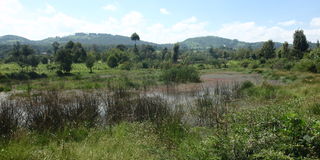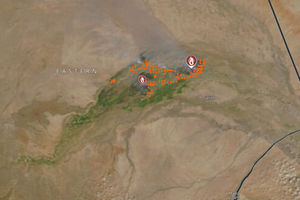Farming activities along the riverbank turn a flowing lifeline into a drying stream

The current state of the Dawani River. PHOTO| POOL
What you need to know:
- The Dawani River originates from the swampy foothills of the forested Dundori Hill, Nakuru County. It meanders through various areas before eventually emptying into Lake Nakuru.
- Across the world, a 2024 report by the World Meteriological Organization (WMO) shows that 2023 was the driest yeras for global rivers in 33 years
The Dawani River originates from the swampy foothills of the forested Dundori Hill, Nakuru County. It meanders through various areas before eventually emptying into Lake Nakuru.
Along its journey, it used to nourish three key dams.
Over the years, the river that used to flow yearlong is nothing more than a seasonal trickle that runs almost dry once the rainy seasons are over. When the dam outflows dry up due to insufficient inflow, the remaining water stagnates, turning stale and emitting a foul odour that can be detected from miles away.
Journalist Frederick Muitiriri, a native of Wanyororo village, fondly recalls his childhood adventures swimming in a local dam—now a shadow of its former glory.
“I recall it was deep, had clear waters and swimming across it was then every boy’s challenge,” he reminiscences.
Mary Wanjiku, a former resident of the village recalls how the dam served as a baptismal pool. “It was not unusual to see faithfuls from different denominations flocking to any of the three dams that the river nourished or partially blocking part of the river with sand filled gunny bags to form baptismal pools. It’s sad to see churches hiring pool services from facilities with swimming pools to conduct this important ritual,” she says.
John Kamanja Kimani, a retired agricultural officer blames human activities for the sorry state of the river.
“This is due to cultivation along the river. I remember my colleagues and I walking up to dozens of farmers carrying out agricultural activities along the river bed. Too close to the river itself,” he says.
He recalls a time when both sides of the riverbanks were adorned with numerous bluegum trees.
He believes the solution doesn’t lie in civic education about riverbank conservation, noting that he spent over 20 years advocating for it during his tenure as a ward manager.
“Only a generation that recognises the problems they’re creating, can make a turnaround to solve this,” he says, his tone a mix of resignation and hope.
He finds the effects of climate change in the area almost ironic, shifting the responsibility squarely onto the shoulders of local residents. He blames those farming along the riverbanks and practicing agriculture under the controversial shamba system in forested areas near the riparian zones.
“Let them obey the 10-meter riverbank rule,” he urges, . “If they do, you’ll see water flowing again—from the forest down to Garu, Riverside, Catholic Dams, Giachong’e, Murunyu, Kwa Mungai, Kiratina, Free Area, Naka, and ultimately into Lake Nakuru.”
His words echo the call for accountability and sustainable practices to restore the river’s once-thriving ecosystem.But locals are not sitting pretty and are taking upon themselves to save the river for posterity’s sake, and also to enjoy its vital resource, water. Recently, they cleared the intakes at different dying springs before peak rains and dredged out sludge.
“Currently, the county government of Nakuru is not invested in reclamation efforts and I’m pushing for that. Through rehabilitation of the river’s source, control of the encroachment of the riparian areas, and the community owning this resource, the river can regain its former status,” said Gathuita Mwangi, a member of the county assembly.
Across the world, a 2024 report by the World Meteriological Organization (WMO) shows that 2023 was the driest yeras for global rivers in 33 years. While climate change is the primary driver for rivers drying up at an alarming rate, unsustainable farming practices have contributed to the drying trend.
The WMO report reveals that agriculture alone accounts for about 70 per cent of freshwater withdrawals from rivers worldwide.
[email protected]




